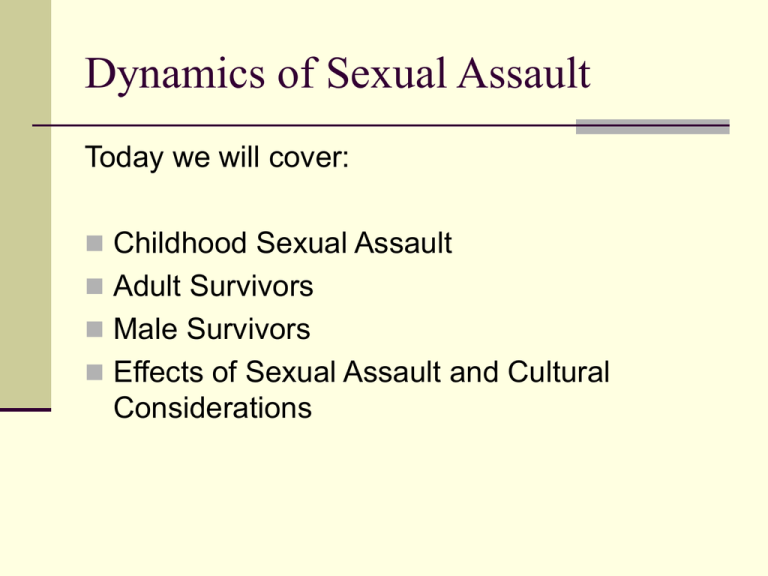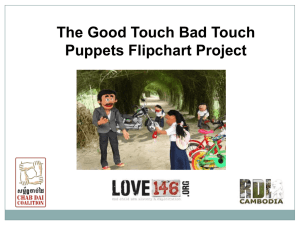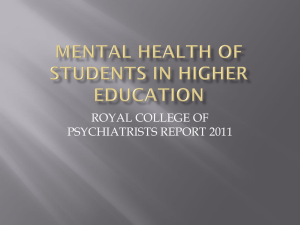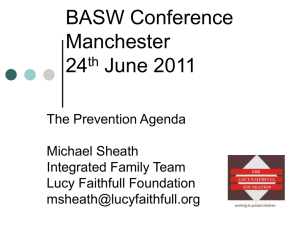Child Sexual Assault
advertisement

Dynamics of Sexual Assault Today we will cover: Childhood Sexual Assault Adult Survivors Male Survivors Effects of Sexual Assault and Cultural Considerations Self-care Please feel free to do whatever you need to take care of yourself. This may be an especially triggering part of the training. It is always fine to leave at any point to… Go for a walk around the block Call a friend Call the helpline (754-6300) Eat a snack Look at pictures of cats Whatever works for you! Child Sexual Assault JEN FRIEDLANDER, SEXUAL ASSAULT ADVOCACY SPECIALIST Today we are going to discuss child sexual abuse. This morning our agenda will focus on: Child Sexual Abuse Grooming Non-offending Parents What do you consider child sexual abuse? Child Sexual Abuse Definitions Child sexual abuse is defined as sexual touching and/or sexual penetration of children. The definition generally includes attempts to touch or penetrate the child as well as completed assaults. Child Sexual Abuse Exposure to pornography Taking nude or sexually suggestive photos of children, peeping Sexual harassment in the form of talking in a sexually inappropriate or intimidating way All forms of sexual contact by an adult with a child are illegal regardless of the circumstances, the use of force or threats, or the child’s behavior Handout – Child Rape Laws The scope of the problem Estimates of lifetime prevalence are that between 20-30% of girls and about 15% of boys will have some kind of sexual abuse experience. Washington State: 38% of women reported some type of sexual assault experience during their lifetime, 80% of which took place before they were 18 years old. The scope of the problem Some cases involve the use of force or threats of violence but most do not. Most incidents of child sexual abuse involve a known or related offender (someone the child trusts). About a third of the cases involve a family member (both immediate and extended). The scope of the problem Only about 10% are committed by strangers. Child sexual abuse can take place within the family, by a parent, step-parent, sibling or other relative; or outside the home, by a friend, neighbor, child care person, teacher, or stranger. When sexual abuse has occurred a child can develop a variety of distressing feelings, thoughts and behaviors which we will discuss in a bit. The scope of the problem Offenders take advantage of the child’s inexperience, curiosity or trusting nature. Offenders may manipulate children by offering rewards. Ageism: Children are usually taught that older people have power and authority over them. Grooming Abusers specifically target their victims and go through a very intentional process of getting close to the child. These dynamics and intentional strategies are part of the “grooming process.” Offenders typically groom the child, the family, and the community. Grooming is the deliberate action taken by an offender to form a trusting relationship with the intent of having sexual contact with a child in the future. Grooming Behavior Competent social skills ensure the abuse is overlooked, viewed as a onetime error in judgment, minimized or blamed on the victim. Child molesters don’t fit the stereotype image of a dangerous sexual predator. Disclosures are often met with reactions of disbelief. This is partly because the community doesn’t really know what child sexual abuse is; they don’t know how to define it. This is also partly due to pervasive denial of child sexual abuse; people don’t know how to acknowledge and deal with the problem. Grooming behaviors There is confusion about what constitutes child sexual abuse, and the subsequent lack of decisiveness about how to respond only assists the molesters, for whom ambiguity and lack of clear responses is an asset. The lack of clarity can lead to tolerating behavior. Impact of Child Sexual Abuse The child’s previous experiences and history Nature of the sexual abuse and the child’s reactions Responses by others upon disclosure of abuse Child’s history Critical pre-abuse factors: History of anxiety problems Previous abuse or other trauma Many studies have shown that the more trauma and adverse life experiences a child has, the higher the risk of developing problems. (ACE study, http://www.acestudy.org/ ) Nature of abuse The relationship between offender and child is an important consideration for how the child will respond. Why? Children can be more seriously affected depending on: o o Length of abuse When children believe that it is their fault Response from others The most important response is how caregivers react to the abuse and that the response in not negative. Reactions that increase the risk for negative outcomes include disbelief, blaming the child for the victimization, or blaming the child for causing trouble to the family or the offender. When the aggressor is a family member The family can be torn about whom to believe, or wants to avoid complications of accepting that a person they care about would do such a thing. When the offender is a parent, the non- offending parent’s response may be affected by their own sexual abuse history, dependency on the offender, and current relationship to the offender and child. Age / developmental factors Children at different ages express the impacts of sexual assault experiences differently. Older children overall tend to be more affected because they have greater cognitive awareness of what sexual assault means and how it might affect other aspects of their lives. Younger children are primarily focused on their immediate safety and security. CSA Survivor Reactions Young children: developmental regression, aggression, and distress at separation from a caregiver Older children: withdraw, avoid situations that are distressing, or shut down emotionally Adolescents who experience severe anxiety may have panic attacks, abuse substances, or engage in self-harming behaviors Supporting Secondary Survivors No matter what the developmental stage of a child, caregivers are the most important influence on children. Insuring that caregivers have accurate information, are supportive to their children, and manage their own emotional reactions in a constructive way is by far the most important factor in helping children When working with children and caregivers we always need to consider the impact that culture has on the child and caregiver. Culture and Community Culture influences how one defines the effects of sexual violence, how one accesses support systems and resources, the victim’s healing and recovery journey, and even whom one tells. All these factors need to be understood if an advocate is to successfully work with survivors and caregivers. It is important to understand that cultural groups interpret their experiences differently, have different experiences with dominant mainstream systems and have different healing strategies. Culture and Community Cultural considerations may include a client’s community, national origin, gender, the language spoken in the home, and spiritual and religious beliefs. Tribal and military communities also have different jurisdiction issues. Awareness and Bias As advocates, we must explore and become aware of our own cultural biases and learn to respect: Boundaries, customs and values of other cultures Traditions that may be different than their own Services and resources that may be used by different cultures Telling and Recanting Divide into two groups. Half of the groups discuss why children don’t tell. Half of the groups discuss first, why children do tell and second, what would make them then recant. Each group will briefly report back to the rest of the training. Telling and Recanting Most children do not tell. The Sexual Assault Clinic tells parents that 95% of children do not disclose. If a child is disclosing sexual assault it should be taken very seriously. Telling and Recanting Children will often let out little bits of information to see how adults will react to what they are saying. This may happen many times before the child actually tells—or not. Often, children will make “Iceberg” disclosures. This usually involves telling that some form of abuse happened, but it is just the tip of the iceberg. This could include just telling about one incident, rather than saying that the abuse has been going on for months. Telling and Recanting Often children believe they have told someone. When children are taught nonanatomical words for their genitals it can interfere with adults understanding that they are disclosing CSA. Telling and Recanting Offenders often tell children that no one will believe them. Children almost NEVER lie about abuse. It is essential that we believe the child. Sexual abuse is almost always a significant and upsetting experience in a child’s life, but in many cases, especially when children tell and are believed and supported, they recover and do not have lasting negative psychological effects.









